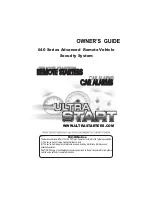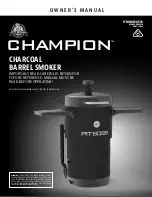
J500-41-00
5
I56-2199-003R
Johnson Control fire panels offer different feature sets across different panel models. As a result, certain features of the DH300RPL may be available
on some control panels, but not on others. The possible features available in the DH300RPL, if supported by the control panel are:
1. Panel controls the LED operation on the duct smoke detector. Operational modes are RED blink, RED continuous, GREEN blink, GREEN continu-
ous, and off.
2. The remote output may be synchronized to the LED operation or controlled independent of the LEDs.
Please refer to the operation manual for the UL listed control panel for specific operation of the DH300RPL.
WIRING INSTRUCTIONS
Disconnect power from the communication line before installing the DH300RPL duct smoke detectors.
Wire the DH300RPL duct smoke detector per the Control Panel Installation Manual and Figures 9, 10 or 11. Set the desired address on the sensor
board code wheel address switches.
NOTE: Some panels support extended addressing. In order to set the sensor above address number 99 on compatible systems, remove the break-
away stop on the left hand rotary switch. Using pliers, carefully twist and pull off stop as shown in Figure 7.
[7] Perform Detector Check
1. Perform STANDBY AND TROUBLE TEST per Section [9.2.1].
2. Perform MAGNET TEST per Section [9.2.2.1]. The RTS451 test of Section [9.2.2.2] may substitute for this requirement.
3. Perform AIR FLOW TEST per Section [9.1].
4. Perform SMOKE RESPONSE TEST per Section [9.1.1].
[8] Install The Cover
Install the cover using the six screws that are captured in the housing cover. Be certain filters
are installed as specified in Section [5]. Make sure that the cover fits into the base groove and
that all gaskets are in their proper positions. Tighten the six screws.
[9] Duct Smoke Detector Maintenance and Test Procedures
Test and maintain duct smoke detectors as recommended in NFPA 72. The tests contained in
this manual were devised to assist maintenance personnel in verification of proper detector
operation.
Before conducting these tests, notify the proper authorities that the smoke detection system will be temporarily out of service. Disable the device or
system under test to prevent unwanted alarms.
[9.1] Smoke Entry Tests
[9.1.1] Air Flow
This product is designed to operate over an extended air speed range of 100 to 4000 FPM. To verify sufficient sampling of ducted air, turn the air han-
dler on and use a manometer to measure the differential pressure between the two sampling tubes. The differential pressure should measure at least
0.0015 inches of water and no more than 1.2 inches of water. Because most commercially available manometers cannot accurately measure very low
pressure differentials, applications with less than 500 FPM of duct air speed may require one of the following: 1) the use of a current-sourcing pressure
transmitter (Dwyer Series 607) per Section 9.1.4 or; 2) the use of aerosol smoke per section 9.1.2.
[9.1.2] Air Flow Test using Aerosol Smoke
This test is intended for low-flow systems (100-500 FPM). If the air speed is greater than 500 FPM, use a conventional manometer to measure differ-
ential pressure between the sampling tubes, as described in 9.1.1.
Drill a
1
⁄
4
″
hole 3 feet upstream from the duct smoke detector. With the air handler on, measure the air velocity with an anemometer. Air speed
must be at least 100 FPM. Spray aerosol smoke* into the duct through the
1
⁄
4
″
hole for five seconds. Wait two minutes for the duct smoke
detector to alarm. If the duct smoke detector alarms, air is flowing through the detector. Remove the duct smoke detector cover and blow
out the residual aerosol smoke from the chamber and reset the duct smoke detector. Use duct tape to seal the aerosol smoke entry hole.
*Aerosol smoke can be purchased from Home Safeguard Industries, Malibu, CA. Phone: 310/457-5813.
Figure 7. Rotary Address Switches
BREAKAWAY STOP
H0112-00


























